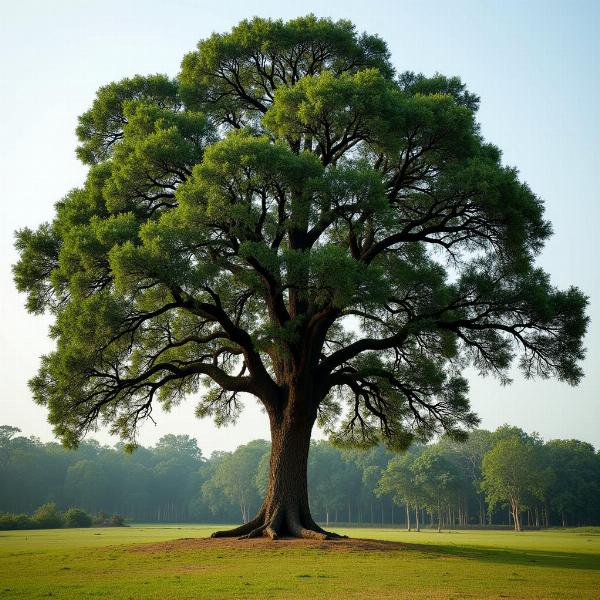The Hindi meaning of oak is “बलूत” (balūt). Understanding the cultural significance and linguistic nuances associated with this word goes beyond a simple translation. This article explores the various aspects of “balūt,” from its literal meaning to its symbolic representations in Indian culture. Are you curious about how this majestic tree is perceived in the Hindi-speaking world? Let’s delve deeper.
Exploring the Term “Balūt” (बलूत)
“Balūt” (बलूत) primarily refers to the oak tree and its wood. While oak trees are not native to India in the same abundance as in some Western countries, the word “balūt” is still recognized and carries a sense of strength and durability. This perception stems from the inherent qualities of oak wood, known for its robustness and longevity. Just like in English, “balūt” can be used to describe objects made from oak wood, such as furniture or building materials.
 Oak Tree in India
Oak Tree in India
Cultural Significance of Oak in India
Although oak trees aren’t as deeply ingrained in Indian folklore as some native trees like the banyan or peepal, they still hold a certain symbolic value. The strength and resilience of oak are often admired and associated with qualities like stability and endurance. Think of how oak is viewed in Western cultures – a symbol of power and longevity. This image transcends geographical boundaries and resonates even in India, where “balūt” evokes a similar sense of awe.
Oak in Literature and Art
While direct references might be less common, the concept of a strong, enduring tree often finds its way into Hindi literature and art. These representations might not always specifically mention “balūt,” but the implied meaning often aligns with the qualities of the oak. For example, a poem describing a tree weathering a storm could evoke the imagery of a sturdy oak, even without explicitly naming it.
Linguistic Nuances of “Balūt”
The word “balūt” itself doesn’t have a wide range of synonyms in Hindi. However, descriptive phrases emphasizing strength and durability can be used to convey a similar meaning. For instance, “मजबूत लकड़ी” (mazbūt lakṛī), meaning “strong wood,” could be used in a context where “balūt” is applicable. The specific choice of words depends on the context and the nuance one wishes to convey. Are you looking to emphasize the wood’s resistance to decay? Or perhaps its ability to withstand heavy loads? The richness of the Hindi language allows for these subtle distinctions.
Common Misconceptions about “Balūt”
One common misconception is that “balūt” refers exclusively to a specific type of Indian tree. While there are trees with similar characteristics, “balūt” specifically denotes the oak tree. Another misconception oakwood meaning in hindi arises from the limited presence of oak trees in India. Some might assume the word is archaic or rarely used. However, “balūt” remains a recognized term, particularly in the context of wood and furniture.
Conclusion
The Hindi meaning of oak, “balūt” (बलूत), encompasses more than just a literal translation. It carries connotations of strength, durability, and resilience, reflecting the inherent qualities of the oak tree itself. From its limited presence in Indian landscapes to its symbolic representation in literature and art, “balūt” holds a unique position within the Hindi lexicon. Understanding the nuances of this word allows for a deeper appreciation of its cultural and linguistic significance. So, next time you encounter “balūt,” remember the image of a majestic oak, standing tall and strong, a testament to its enduring nature.
FAQ
- What is the exact Hindi word for oak? The exact Hindi word for oak is “बलूत” (balūt).
- Are oak trees common in India? Oak trees are not as common in India as in some Western countries.
- Is “balūt” used in everyday Hindi conversation? While not as common as other tree names, “balūt” is still a recognized term, particularly in specific contexts like furniture making.
- Does “balūt” have any symbolic meaning in Indian culture? “Balūt” is often associated with strength and durability, reflecting the qualities of oak wood. cloaks meaning in hindi
- What are some other Hindi words related to “balūt”? While “balūt” doesn’t have direct synonyms, phrases like “मजबूत लकड़ी” (mazbūt lakṛī – strong wood) can be used in similar contexts.
- Is there a difference between “balūt” and other strong woods in Hindi? “Balūt” specifically refers to oak wood, distinguishing it from other strong woods that might have different names in Hindi. meaning of croaked in hindi
- Where can I find more information about the cultural significance of trees in India? meaning of cloak in hindi You can explore books on Indian botany, folklore, and traditional practices for more information. hindi meaning of cloak
Meaning-Hindi.in is your trusted partner for professional Hindi translation services. We specialize in a wide range of translation needs, from business and legal documents to technical manuals and website localization. Our team of expert linguists ensures accurate and culturally sensitive translations, bridging the language gap for businesses and individuals alike. Contact us today for all your Hindi translation requirements at [email protected] or call us at +91 11-4502-7584. Let Meaning-Hindi.in help you connect with the Hindi-speaking world!